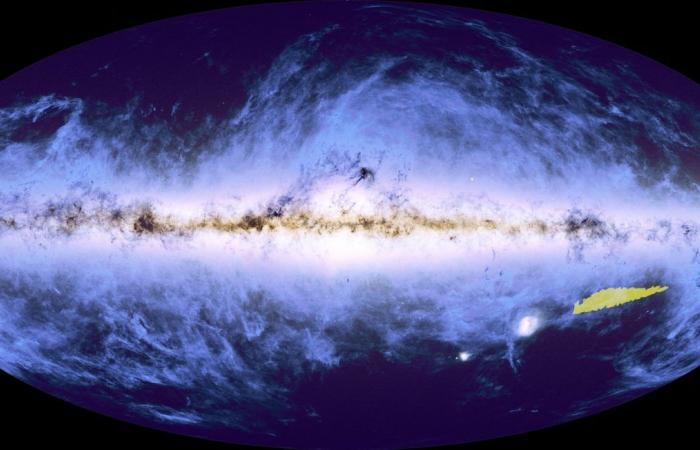Stars in your eyes. The European Space Agency (ESA) has unveiled a first part of the map of the Universe produced by the Euclid telescope to unravel the mystery of dark matter. In total: one hundred million stars and galaxies in a single image.
On the narrow band of deep black, dotted with scintillating points, stretch vaporous blue clouds: “galactic cirrus”, a mixture of dust and gas “from which new stars will form”, explains to AFP Bruno Altieri, ESA scientist in charge of the Euclid archive.
Only 1% of the total map
By zooming in very deeply, one can see the complex structure of a spiral galaxy or two galaxies interacting with each other. “In this image alone, there are already tens of millions of galaxies, thanks to which we will be able to produce statistics on where certain types of galaxies are found in relation to others, how they evolve over time, why they have not formed stars for a few billion years…” explains Altieri. [Voir ci-dessous]
By clicking on“I accept”you accept the deposit of cookies by external services and will thus have access to the content of our partners.
More information on the Cookie management policy page
I accept
This “breathtaking” image is the first piece (only 1%) of a map which, in six years, “will reveal more than a third of the sky”, underlines Valeria Pettorino, Euclid project scientist at ESA in a press release published Wednesday. A 208 gigapixel mosaic, it was produced from 260 observations made by Euclid in just two weeks, between March 25 and April 8. The telescope covered 132 square degrees of the southern sky, or 500 times the apparent surface of the Moon.
Unraveling the mystery of dark matter
Launched in July 2023, Euclid can encompass a large scene in a single image thanks to its wide field of view in visible light and infrared. Unlike the James Webb space telescope (its neighbor approximately 1.5 million km from Earth) which sees narrower but further.
Its ultimate objective is to shed light on one of the greatest scientific enigmas, that of dark matter and dark energy, which constitute 95% of the Universe but about which we know almost nothing. Dark matter (25% of the Universe) and dark energy (70%) have opposite effects: while the first ensures the cohesion of galaxies, dark energy causes the expansion of the Universe.
For the first, dark matter, we know that it exists because of a mysterious observation: it is impossible to explain how a galaxy or a group of galaxies does not disperse by only taking into account the gravity of their visible elements. (planets, stars, etc.). “It cannot be observed directly, but we can see its gravitational effects,” recalls Altieri.
Dark energy and the expansion of the universe
Since the 1990s, we have also known that the expansion of the Universe is accelerating, which implies the existence on very large scales of a repulsive force: dark energy. The acceleration of this expansion would have started six billion years ago. Thanks to its 3D map, Euclid will allow precise measurements of the distribution of galaxies and the expansion of the Universe and thus refine theoretical cosmological models.
By capturing the shapes, distances and movements of billions of galaxies up to 10 billion light years away, “we can deduce the distance of galaxies in different ways, through photometric and spectroscopic images, and watch how the structures in the Universe, because the further we look, the further back in time we go,” explains Altieri.
Euclid will notably make it possible to look at a part of the Universe between 10 and 4-5 billion light years away, “where all these structures have evolved a lot, and where dark energy has started to come into play”, adds- he.






